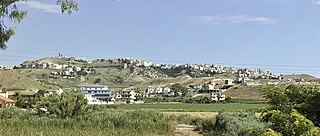
Lydia was an Iron Age kingdom of western Asia Minor located generally east of ancient Ionia in the modern western Turkish provinces of Uşak, Manisa and inland Izmir. The ethnic group inhabiting this kingdom are known as the Lydians, and their language, known as Lydian, was a member of the Anatolian branch of the Indo-European language family. The capital of Lydia was Sardis.

Convolvulaceae, commonly called the bindweeds or morning glories, is a family of about 60 genera and more than 1,650 species. These species are primarily herbaceous vines, but also include trees, shrubs and herbs. The tubers of several species are edible, the best known of which is the sweet potato.

Croesus was the king of Lydia, who reigned from 585 BC until his defeat by the Persian king Cyrus the Great in 547 or 546 BC. According to Herodotus, he reigned 14 years.

The Battle of Thymbra was the decisive battle in the war between Croesus of the Lydian Kingdom and Cyrus the Great of the Achaemenid Empire. Cyrus, after he had pursued Croesus into Lydia after the drawn Battle of Pteria, met the remains of Croesus' partially-disbanded army in battle on the plain north of Sardis in December 547 BC. Croesus' army was about twice as large and had been reinforced with many new men, but Cyrus still utterly defeated it. That proved to be decisive, and after the 14-day Siege of Sardis, the city and possibly its king fell, and Lydia was conquered by the Persians.

Graham Island is a submarine volcano in the Mediterranean Sea near the island of Sicily that has, on more than one occasion, risen above the surface of the Mediterranean via volcanic action and soon thereafter been washed away. Since 300 BC this cycle of events has occurred four times.

Rocca di Neto is a town and comune of the province of Crotone in the Calabria region of southern Italy. It is crossed by the Neto river from which it takes its current name; until 1863 it was known as Rocca Ferdinandea in honour of king Ferdinand I of Two Sicilies.

Ornithoptera croesus, the Wallace's golden birdwing, is a species of birdwing butterfly found in northern Maluku in Indonesia.

The siege of Sardis was the last decisive conflict after the Battle of Thymbra, which was fought between the forces of Croesus of Lydia and Cyrus the Great, when Cyrus followed Croesus to his city, laid siege to it for 14 days and captured it.

Ferdinandea is a genus of syrphid flies or hoverflies in the family Syrphidae. There are about 16 described species in Ferdinandea.
The Central Norseman gold mine is located at Norseman, Western Australia. Norseman lies at the southern end of the Norseman-Wiluna Greenstone Belt, in the Eastern Goldfields Province of the Yilgarn Block, Western Australia.
The Davyhurst Gold Mine is a gold mine located 53 km south-west of Menzies, near Davyhurst.
Axiocerses croesus, the dark-banded scarlet, is a butterfly of the family Lycaenidae. It is found in the Eastern Cape, west up to Port Elizabeth and into Kwazulu-Natal.

Treviglio railway station, also known as Treviglio centrale railway station is the main station serving the town and comune of Treviglio, in the region of Lombardy, northern Italy. Opened in 1878, it has a higher average number of passengers per day than Treviglio's other railway station, Treviglio Ovest.

Semomesia croesus, also known as the Croesus eyemark, is a species of butterfly in the family Riodinidae. It is found in most of South America.

Chrysiridia croesus, the East African sunset moth, is a moth of the family Uraniidae. As suggested by its common name, it is found in East Africa, including Kenya, Tanzania, Mozambique and Zimbabwe. The species was first described by Carl Eduard Adolph Gerstaecker in 1871.
Notonomus croesus is a species of ground beetle in the subfamily Pterostichinae. It was described by Castelnau in 1867.
Ferdinandea buccata is a species of syrphid fly in the family Syrphidae.
Valenzuela croesus is a species of lizard barklouse in the family Caeciliusidae. It is found in Central America and North America.

Anisocentropus is a genus of caddisflies in the family Calamoceratidae. There are more than 60 described species in Anisocentropus.

The Paparoa Track is a 55.7 km (34.6 mi) shared hiking and mountain biking track located in Paparoa National Park in the South Island of New Zealand. The track was created as a memorial for the 29 miners who lost their lives in the Pike River Mine disaster. The track is the tenth Great Walk to be created and has been fully open since 1 March 2020. It was the first addition to the Great Walks in 25 years.














